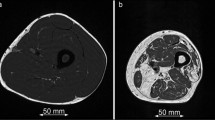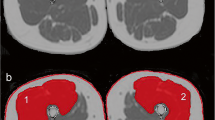Abstract
Background
Various skeletal muscle diseases result in fatty infiltration, making it important to develop noninvasive biomarkers to objectively measure muscular fat.
Objective
We compared T2 relaxation time mapping (T2 maps) and magnetic resonance spectroscopy (MRS) with physical characteristics previously correlated with intramuscular fat to validate T2 maps and MRS as objective measures of skeletal muscle fat.
Materials and methods
We evaluated gluteus maximus muscles in 30 healthy boys (ages 5–19 years) at 3 T with T1-weighted images, T2-W images with fat saturation, T2 maps with and without fat saturation, and MR spectroscopy. We calculated body surface area (BSA), body mass index (BMI) and BMI percentile (BMI %). We performed fat and inflammation grading on T1-W imaging and fat-saturated T2-W imaging, respectively. Mean T2 values from T2 maps with fat saturation were subtracted from T2 maps without fat saturation to determine T2 fat values. We obtained lipid-to-water ratios by MR spectroscopy. Pearson correlation was used to assess relationships between BSA, BMI, BMI %, T2 fat values, and lipid-to-water ratios for each boy.
Results
Twenty-four boys completed all exams; 21 showed minimal and 3 showed no fatty infiltration. None showed muscle inflammation. There was correlation between BSA, BMI, and BMI %, and T2 fat values (P < 0.05), and between BMI and BMI %, and lipid-to-water ratios (P < 0.05). There was strong correlation between T2 fat values and lipid-to-water ratios (P < 0.0001, r = 0.83).
Conclusion
T2 maps and MR spectroscopy correlate with physical characteristics associated with fatty infiltration of skeletal muscles, even in microscopic amounts, and validate each other. Both techniques might enable detection of minimal pathological fatty infiltration in children with skeletal muscle disorders.






Similar content being viewed by others
References
Janssen I, Heymsfield SB, Allison DB et al (2002) Body mass index and waist circumference independently contribute to the prediction of nonabdominal, abdominal subcutaneous, and visceral fat. Am J Clin Nutr 75:683–688
Komiya H, Mori Y, Yokose T et al (2006) Effect of intramuscular fat difference on glucose and insulin reaction in oral glucose tolerance test. J Atheroscler Thromb 13:136–142
Kovanlikaya A, Mittelman SD, Ward A et al (2005) Obesity and fat quantification in lean tissues using three-point Dixon MR imaging. Pediatr Radiol 35:601–607
Schreiber A, Smith WL, Ionasescu V et al (1987) Magnetic resonance imaging of children with Duchenne muscular dystrophy. Pediatr Radiol 17:495–497
May DA, Disler DG, Jones EA et al (2000) Abnormal signal intensity in skeletal muscle at MR imaging: patterns, pearls, and pitfalls. Radiographics 20:S295–S315
Gaeta M, Messina S, Mileto A et al (2012) Muscle fat-fraction and mapping in Duchenne muscular dystrophy: evaluation of disease distribution and correlation with clinical assessments. Preliminary experience. Skeletal Radiol 41:955–961
Wren TA, Bluml S, Tseng-Ong L et al (2008) Three-point technique of fat quantification of muscle tissue as a marker of disease progression in Duchenne muscular dystrophy: preliminary study. AJR Am J Roentgenol 190:W8–W12
Kim HK, Laor T, Horn PS et al (2010) T2 mapping in Duchenne muscular dystrophy: distribution of disease activity and correlation with clinical assessments. Radiology 255:899–908
Kim HK, Laor T, Horn PS et al (2010) Quantitative assessment of the T2 relaxation time of the gluteus muscles in children with Duchenne muscular dystrophy: a comparative study before and after steroid treatment. Korean J Radiol 11:304–311
Maillard SM, Jones R, Owens C et al (2004) Quantitative assessment of MRI T2 relaxation time of thigh muscles in juvenile dermatomyositis. Rheumatology 43:603–608
Cousins JP (1995) Clinical MR spectroscopy: fundamentals, current applications, and future potential. AJR Am J Roentgenol 164:1337–1347
Li X, Youngren JF, Hyun B et al (2008) Technical evaluation of in vivo abdominal fat and IMCL quantification using MRI and MRSI at 3 T. Magn Reson Imaging 26:188–197
Mengiardi B, Schmid MR, Boos N et al (2006) Fat content of lumbar paraspinal muscles in patients with chronic low back pain and in asymptomatic volunteers: quantification with MR spectroscopy. Radiology 240:786–792
Centers for Disease Control and Prevention (2011) Healthy weight: it’s not a diet, it’s a lifestyle! Retrieved from http://www.cdc.gov/healthyweight/assessing/bmi/childrens_bmi/about_childrens_bmi.html. Accessed Aug. 26, 2013
Patten C, Meyer RA, Fleckenstein JL (2003) T2 mapping of muscle. Semin Musculoskelet Radiol 7:297–305
Tannus A, Garwood M (1997) Adiabatic pulses. NMR Biomed 10:423–434
Mercuri E, Pichiecchio A, Allsop J et al (2007) Muscle MRI in inherited neuromuscular disorders: past, present, and future. J Magn Reson Imaging 25:433–440
Kim HK, Lindquist DM, Serai SD et al (2013) Magnetic resonance imaging of pediatric muscular disorders: recent advances and clinical applications. Radiol Clin North Am 51:721–742
Kim HK, Merrow AC, Shiraj S et al (2013) Analysis of fatty infiltration and inflammation of the pelvic and thigh muscles in boys with Duchenne muscular dystrophy (DMD): grading of disease involvement on MR imaging and correlation with clinical assessments. Pediatr Radiol. doi:10.1007/s00247-013-2696-z
Carlo B, Roberta P, Roberto S et al (2006) Limb-girdle muscular dystrophies type 2A and 2B: clinical and radiological aspects. Basic Appl Myol 16:17–25
Dardzinski BJ, Laor T, Schmithorst VJ et al (2002) Mapping T2 relaxation time in the pediatric knee: feasibility with a clinical 1.5-T MR imaging system. Radiology 225:233–239
Mosher TJ, Dardzinski BJ (2004) Cartilage MRI T2 relaxation time mapping: overview and applications. Semin Musculoskelet Radiol 8:355–368
Kim HK, Laor T, Graham TB et al (2010) T2 relaxation time changes in distal femoral articular cartilage in children with juvenile idiopathic arthritis: a 3-year longitudinal study. AJR Am J Roentgenol 195:1021–1025
Horn PS, Pesce AJ (2005) Reference intervals: a user’s guide. AACC Press, Washington, DC
Prior BM, Foley JM, Jayaraman RC et al (1999) Pixel T2 distribution in functional magnetic resonance images of muscle. J Appl Physiol 87:2107–2114
Huang Y, Majumdar S, Genant HK et al (1994) Quantitative MR relaxometry study of muscle composition and function in Duchenne muscular dystrophy. J Magn Reson Imaging 4:59–64
Marden FA, Connolly AM, Siegel MJ et al (2005) Compositional analysis of muscle in boys with Duchenne muscular dystrophy using MR imaging. Skeletal Radiol 34:140–148
Acknowledgments
The paper was presented at RSNA 2011.
This research project was supported by the RSNA seed grant, the Fujifilm Medical System RSNA Research Seed Grant 2010–2011 and the Society for Pediatric Radiology Seed Grant 2009–2010.
Conflicts of interest
None.
Author information
Authors and Affiliations
Corresponding author
Rights and permissions
About this article
Cite this article
Kim, H.K., Serai, S., Merrow, A.C. et al. Objective measurement of minimal fat in normal skeletal muscles of healthy children using T2 relaxation time mapping (T2 maps) and MR spectroscopy. Pediatr Radiol 44, 149–157 (2014). https://doi.org/10.1007/s00247-013-2791-1
Received:
Revised:
Accepted:
Published:
Issue Date:
DOI: https://doi.org/10.1007/s00247-013-2791-1




